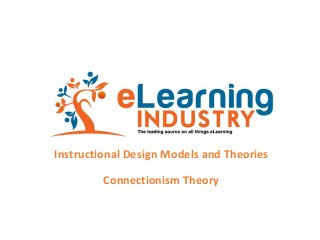
Instructional Design Models and Theories: Connectionism Theory
- 1. Instructional Design Models and Theories Connectionism Theory
- 2. Christopher Pappas Founder of the eLearning Industry's Network elearningindustry.com •eLearning Consultant and Analyst in various USA and EU organizations. •eLearning Blogger at eLearningIndustry.com •M.B.A. & M.Ed. from BGSU, Ohio, USA. If I can be valauable to you do not hesitate to contact me •https://www.linkedin.com/in/christopherpappas •https://plus.google.com/u/0/+ChristopherPappas/posts •https://twitter.com/cpappas •https://www.facebook.com/christoforos.pappas
- 3. Instructional Design Models and Theories Join us at the Instructional Design History Journey A New Instructional Design Model Will Be Added Every Week! Find more at: Instructional Design Models and Theories http://elearningindustry.com/instructional-design-models-and-theories
- 4. 1910 – Edward Thorndike introduces hisLaws and Connectionism Theory, which are based on the Active Learning Principles.
- 5. Objectives Thorndike’s Laws and Connectionism Theory • Which are the Thorndike’s Laws and Principles •What is Connectionism Theory
- 6. Edward Thorndike • Edward Thorndike in 1910 introduces his famous set of principles, known as Thorndike’s Laws. According to these Laws, learning is achieved when an individual is able to form associations between a particular stimulus and a response. These associations are known as “habits”, and can either be encouraged or deterred by external parameters and the frequency an individual is exposed to the stimulus and the response.
- 7. Section 1 Thorndike’s Laws and Principles
- 8. Thorndike’s Laws 1. Law of effect An individual's response to a specific situation, followed by a reward, will eventually make those responses stronger. If a response deters an individual from achieving a reward, or a “rewarding state”, it becomes weaker. 2. Law of readiness A series or a set of responses can be linked together in order to achieve a goal. If the person is prevented from achieving this goal, this will cause “annoyance”. 3. Law of exercise Frequently made associations become strengthened. Likewise, rare or sporadic associations become weaker.
- 9. Thorndike’s Additional Laws and Principles 1. Multiple responses In any given situation, an individual might react in a variety of ways if the initial reaction does not immediately lead to a satisfying result. 2. Set of attitudes Individuals are inclined to react in a particular way. These reactions are unique for species or groups of related species. 3. Prepotency of elements Individuals are able to filter out any irrelevant aspects of a particular situation and respond only to significant parameters that directly affect this situation. 4. Response by analogy Reactions from a previously experienced situation might be transferred to a new one. This is also called Theory of Identical Elements. 5. Associative shifting Sometimes, a reaction to a certain stimulus might shift to a different one.
- 10. Section 2 Thorndike’s Connectionism Theory
- 11. The Stages of Classical Conditioning Thorndike’s Connectionism Theoryis based on the ideas presented by associationism. In this theory, Thorndike hypothesized that certain elements become associated though similar experiences and that more complex ideas can be taught or explained through a series of simplified rules. In this theory, there are four key principles: 1. Learning involves both practice and a reward system (based upon the law of effect). 2. Stimulus and response associations can be linked if they are part of the same “action sequence” (based upon the law of readiness). 3. The transfer of knowledge and learning is based on situations that have been previously experienced by the individual. 4. Intelligence is determined by how many of these associations have been learned and/or acquired.
- 12. Connectionism Theory Find more at: Connectionism Theory
- 13. Free eLearning Resources Top 10 e-Learning Statistics for 2014 You Need To Know http://elearningindustry.com/top-10-e-learning-statistics-for-2014-you-need-to-know Awesome e-Learning Course Guide http://elearningindustry.com/awesome-e-learning-course-guide The Free eBook: How to become an eLearning Professional http://elearningindustry.com/the-free-ebook-how-to-become-an-elearning-professional Over 1000 Free eLearning Resources http://elearningindustry.com/over-1000-free-elearning-resources
